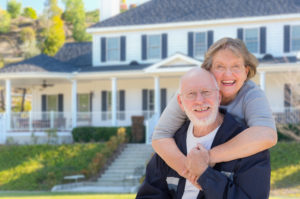Happy March Madness everyone! Every Monday we like to recap the most engaging content, or should I say “top picks,” from the previous week.
This week, Next Avenue explores the various ways virtual reality supports older adults. Then, Chronogram dives deep into the realities (and possibilities) seniors face when aging in place.
Most Shared: Seeing is believing healing!
It’s no secret that as we age capabilities and activities often change and can become a bit more limited. However, companies like Rendever are busy creating technology to help combat these changes — developing programs for seniors that use algorithms that convert 360 panoramic photos into a unique virtual experience. This will allow seniors, who can no longer travel, to escape reality and explore. The impact virtual reality can have on seniors’ quality of life is significant in more ways than one.
- Memories last a lifetime: Virtual reality programs allow older adults to experience major family events (even from afar). They no longer have to worry about the stress of traveling or missing out on a loved one’s milestone events. Virtual reality programmers have developed a tool that will allow an event (or experience) that is captured by camera to be recreated into a virtual experience.
- The sky is the limit: Slip on a pair of virtual goggles and you can go anywhere. This type of exploring is great for the aging mind. Some seniors prefer to explore new places while others find comfort in simply “going home” (seeing their old house, streets and neighborhood). Studies show that virtual reality can stimulate the brain and ignite neuropathways.
- Out of sight, out of mind: Virtual reality technology may have physical benefits. Studies suggest it can serve as a distraction from confusion or pain and has proven to improve the quality of life for those suffering from dementia.
Virtual reality technology improves senior’s quality of life so many different ways. From being able to experience special life moments from afar or improving brain function by taking a virtual adventure to simply being a sweet distraction for those seniors who currently live with pain or confusion.
To learn more about how virtual reality is healing aging adults click here.
Most Clicked: Aging In Place: The Good, Bad and Ugly
In this week’s most clicked item, an article by Jim Gordon, written for Chronogram, takes an in-depth look at the steps that need to be taken in order to make sure that seniors who make the decision to age in place live a healthy life at home.
There are some technological advancements making some real headway in helping seniors who face isolation as they age at home. Companies like IBM and Toyota are even perfecting care-bots that will tend to seniors living alone.
European studies show that seniors really desire to get out of the house more, but feel restricted for safety reasons. Researchers suggest that creating short distances close together with staging posts could be effective to combat these fears. Things like sidewalks, benches and bathrooms all close together will reduce senior worries when leaving home.
If we don’t take the necessary measures to ensure that seniors can age in place with as little stress as possible, such as making sure that public spaces are made accessible for seniors, the possibility of some of the negative effects of aging in place increases. These effects include isolation and isolation, which in turn, can lead to a variety of health problems and an increased mortality rate, as noted by Gordon in the article.
The article reiterates that, with the number of seniors rising, there will not be enough residential facilities to accommodate everyone. For many, aging in place will be not only their best option, but the only one they have.
Many continuing care retirement communities (CCRC) have started to offer programs for older adults who have decided to remain at home, including North Hill. The Massachusetts-based CCRC launched the Connected for Life Lifecare at Home program in April 2016.
Programs such as Connected for Life connect seniors aging at home with the services and resources they may need in order to ensure that they remain healthy, active and engaged while living at home.
If your community has an aging-in-place program, or is considering launching one, Creating Results suggests including some of these features in your program in order to best serve off-campus members of your community:
- Personal Care Coordination: ensure that older adults have someone to help coordinate all of their health service needs.
- Engagement Opportunities: introduce older adults who are aging in place to events and activities in the community where they can pursue their passions and meet people who share their interests.
- Transportation Coordination: make sure that seniors who need help getting around have regular access to transportation services, thus preventing isolation in the home.
- In-Home Services: some seniors may need a little bit of extra help buying groceries, preparing meals or tending to other activities at home; they should be able to count on you to introduce them to services that will make aging in place a breeze.
To read the entire article, click here: http://bit.ly/2nIpdA7




